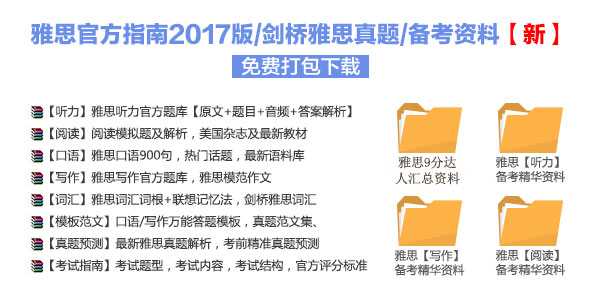劍橋雅思閱讀4原文解析(test1)
2017/2/17 11:55:41來源:新航道作者:新航道
摘要:劍橋雅思系列真題是劍橋大學考試委員會外語考試部出版各類考試真題的唯一官方出版社出版的權威教材,書中包含最新的雅思全真試題資料。
劍橋雅思系列真題是劍橋大學考試委員會外語考試部出版各類考試真題的唯一官方出版社出版的權威教材,書中包含最新的雅思全真試題資料,是各類雅思考生備考過程中必不可少的參考書。非常適合學生自學的習題解答和聽力錄音文本。
Question 1
答案:FALSE
關鍵詞:media
定位原文:第1段第3句“In the face of the frequent and often vivid media coverage…”;“Despite the extensive coverage in the popular media of the destruction of rainforests…”
解題思路:這兩段當中的frequent/vivid/extensive/coverage等詞都說明媒體對于熱帶雨林的現狀十分關注,并做了廣泛報道。
Question 2
答案:FALSE
關鍵詞:children/classroom
定位原文:第2段第3句“These ideas may be developed by children absorbing ideas through the popular media。”這些觀點可能是學生從大眾媒體中獲得的。
解題思路:這句話證明學生也從大眾媒體中吸取有關熱帶雨林的觀點,而并不是只從課堂中得到相關知識。
Question 3
答案:TRUE
關鍵詞:pure/ mistaken
定位原文:第2段第1句“Many studies have shown that children harbour misconceptions about ‘pure’, curriculum science.”
解題思路:這句話是題干的同義替換,學生關鍵需要掌握“harbour”在這里的意思等于“hold”。
Question 4
答案:TRUE
關鍵詞:framework/easier
定位原文:第2段第2句“These misconceptions do not remain isolated but become incorporated into a multifaceted,but organized, conceptual framework, making it and the component ideas, some of which are erroneous, more robust but also accessible to modification.”
解題思路:解這題的關鍵是要明白題干中的“easier to change”和文中的“accessible to modification”是同義替換。
Question 5
答案:FALSE
關鍵詞:yes/no
定位原文:第4段第2句“Secondary school children were asked to complete a questionnaire containing five open-form questions.”
解題思路:Open-form指簡答題,與yes/no直接矛盾。
Question 6
答案:NOT GIVEN
關鍵詞:more likely than
定位原文:第5段第4句“More girls (70%) than boys (60%) raised the idea of rainforest as animal habitats.”
第6段第1句“Similarly, but at a lower level, more girls (13%) than boys (5%) said that rainforests provided human habitats.”
解題思路: 雖然這兩句話分別將男生女生作了比較,但是比較內容并不是關于熱帶雨林破壞的錯誤觀點,所以此題屬于并不存在的比較關系。
Question 7
答案: TRUE
關鍵詞:follow on from
定位原文:第6段第2句“These observations are generally consistent with our previous studies of pupils’ views about the use and conservation of rainforests…”
解題思路:“previous”一詞是先前的意思,證明在此研究之前,人們也就學生對熱帶雨林的看法做了研究,因此本文所提到的調査是在這些研究之后進行的。
Question 8
答案:NOT GIVEN
關鍵詞:primary/second
解題思路:文中直到最末尾也從未提到這項研究是否會繼續,所以此題屬于無中生有。
Question 9
答案:M
關鍵詞:where/ rainforests
定位原文:第4段第6句“The commonest responses were continents or countries: Africa (given by 43% of children), South America (30%), Brazil (25%).”
解題思路:根據對應句信息可選出答案為M。
Question 10
答案:E
關鍵詞:importance/rainforests
定位原文:第9段第1句…the majority of children simply said that we need rainforests to survive.
解題思路:根據對應句信息可選出答案為E。
Question 11
答案:G
關鍵詞:reason/loss
定位原文:第7段第2句“...more than half of the pupils(59%)identified that it is human activities which are destroying rainforests,...”
解題思路:根據對應句信息可選出答案為G。
Question 12
答案:P
關鍵詞:important/protected
定位原文:第5段第2句“The dominant idea, raised by 64% of the pupils, was that rainforests provide animals with habitats.”
解題思路:根據對應句信息可選出答案為P。
Question 13
答案:J
關鍵詞:uncommon/issue
定位原文:第9段第2句至第3句“Only a few of the pupils(6%)mentioned that rainforest destruction may contribute to global warming. This is surprising considering the high level of media coverage on this issue.”
解題思路:根據對應句信息可選出答案為J。
Question 14
答案:B
關鍵詞:title
定位原文:無
解題思路:從文章第二段開始,一直在圍繞孩子對熱帶雨林容易產生錯誤的理解,因此本文重點應該放在孩子對熱帶雨林遭破壞狀況的觀點上,故要選擇一個帶有孩子的標題。
Question 15
答案:taste buds
關鍵詞:taste
定位原文:第1段第5句“Similarly, although at least some cetaceans have taste buds, the nerves serving these have degenerated or are rudimentary.”
解題思路:根據定位句信息,可知答案是taste buds。
Question 16
答案:baleen whales
關鍵詞:stereoscopic vision
定位原文:第3段第3句“However,the position of the eyes so restricts the field of vision in baleen whales that they probably do not have stereoscopic vision.”
解題思路:根據定位句信息,可知答案是baleen whales。
Question 17
答案:forward downward (IN EITHER ORDER)
關鍵詞:Dolphins, porpoises
定位原文:第4段第1句“On the other hand, the position of the eyes in most dolphins and porpoises suggests that they have stereoscopic vision forward and downward.”
解題思路:根據定位句信息,可知答案是forward和downward。
Question 18
答案:(the) freshwater dolphin(s)
關鍵詞:forward and upward
定位原文:第4段第2句“Eye position in freshwater dolphins, which often swim on their side or upside down while feeding, suggests that what vision they have is stereoscopic forward and upward.”
解題思路:根據關鍵詞定位,可知答案為freshwater dolphin(s)。
Question 19
答案:(the) water
關鍵詞:bottlenose dolphin
定位原文:第4段第3句“By comparison, the bottlenose dolphin has extremely keen vision in water. Judging from the way it watches and tracks airborne flying fish, it can apparently see fairly well through the air-water inter?face as well.”
解題思路:題干中的exceptional和文中的extremely是同義替換,所以根據定位句答案應該為water。
Question 20
答案:(the) lower frequencies
關鍵詞:most large baleen
定位原文:第6段第3句“Large baleen whales primarily use the lower frequencies and are often limited in their repertoire.”
解題思路:根據定位句信息,可知答案是(the) lower frequencies。
Question 21
答案:bowhead humpback (IN EITHER ORDER)
關鍵詞:song-like
定位原文:第6段第4句“Notable exceptions are the nearly song-like choruses of bowhead whales in summer and the complex, haunting utterances of the humpback whales.”
解題思路:根據song-like定位到該句話,可知答案為bowhead和humpback。
Question 22
答案:touch/sense of touch
關鍵詞:mating
定位原文:第2段第3句“This contact may help to maintain order within a group, and stroking or touching are part of the courtship ritual in most species.”
解題思路:這里的mating和文中的courtship ritual是同義替換,所以答案應為touch或者sense of touch。
Question 23
答案:freshwater dolphin(s)
關鍵詞:upside down/eating
定位原文:第4段第2句“Eye position in freshwater dolphins, which often swim on their side or upside down while feeding...”
解題思路:根據定位句信息,可知答案是freshwater dolphin(s)。
Question 24
答案:airborne flying fish
關鍵詞:follow/under the water
定位原文:第4段第3句“By comparison, the bottlenose dolphin has extremely keen vision in water. Judging from the way it watches and tracks airborne flying fish, it can apparently see fairly well through the air-water interface as well.”
解題思路:題目中的“follow”和文中的“tracks”是同義替換,根據定位句信息,可知答案是airborne flying fish。
Question 25
答案:clear water(s)/clear open water(s)
關鍵詞:habitat/good visual ability
定位原文:第5段第句“For example, vision is obviously more useful to species inhabiting clear open waters than to those living in turbid rivers and flooded plains.”
解題思路:根據定位句信息,可知答案是clear open water(s)。
Question 26
答案:(the) acoustic sense
關鍵詞:best/cetaceans
定位原文:第6段第1句“Although the senses of taste and smell appear to have deteriorated, and vision in water appears to be uncertain, such weaknesses are more than compensated for by cetaceans’ well-developed acoustic sense.”
解題思路:根據定位句信息,可知答案是acoustic sense。
Question 27
答案:C
關鍵詞:first paragraph
定位原文:第1段第1句“From a number of recent studies, it has become clear that blind people can appreciate the use of outlines and perspectives to describe the arrangement of objects and other surfaces in space.”
解題思路:根據定位句可知,說的是盲人能夠理解outlines和perspectives的使用。故正確答案為C。
Question 28
答案:C
關鍵詞:surprised/blind woman
定位原文:第1段第3-5句“This fact was drawn to my attention dramatically when a blind woman in one of my investigations decided on her own initiative to draw a wheel as it was spinning. To show this motion, she traced a curve inside the circle (Fig.1). I was taken aback. Lines of motion, such as the one she used, are a very recent invention in the history of illustration.”
解題思路:這段話說到讓作者驚訝的是一個盲人女性決定靠自己的能力繪出正在旋轉的輪椅。故正確答案為C選項。
Question 29
答案:A
關鍵詞:Part1/ blind subjects
定位原文:第5段第4句“Evidently, however, the blind not only figured out meanings for each line of motion,but as a group they generally came up with the same meaning at least as frequently as did sighted subjects.”
解題思路:從“not only…but…came up with the same meaning as least as frequently as did sighted subjects” 可以得出A選項正確。這里并沒有說比sighted subjects會好,所以D選項是不對的。
Question 30
答案:E
關鍵詞:無
定位原文:Part1第4段最后一句“Subjects assumed that spokes extending beyond the wheel's perimeter signified that the wheel had its brakes on...”
解題思路:這段話恰好說明輻條超出了車輪的周界是使用了剎車,所以正確答案為E。
Question 31
答案:C
關鍵詞:無
定位原文:Part1第4段最后一句“...and that dashed spokes indicated the wheel was spinning quickly.”
解題思路:這句話的意思是虛線輻條表示車輪在快速轉動,故正確答案為C。
Question 32
答案:A
關鍵詞:無
定位原文:Part1第4段第2句“Most guessed that the curved spokes indicated that the wheel was spinning steadily…”
解題思路:這句話的意思是曲線輻條表示車輪在穩定的轉動,故正確答案為A。
Question 33
答案:pairs
關鍵詞:Part2/a set of word
定位原文:Part2第2段第1句“We gave a list of twenty pairs of word of words to sighted subjects...”
解題思路:此空要求填一個名詞,而詞庫中只有associations, pairs, shapes, words四個詞是名詞,從意思上判斷,words和shapes顯然不太合適,最后只能填pairs。
Question 34
答案:shapes
關鍵詞:abstract
定位原文:Part2第3段最后一句“Thus, we concluded that the blind interpret abstract shapes as sighted people do.”
解題思路:Abstract是形容詞,空里要求填個名詞。從對應句可以看出改名詞為shapes。
Question 35
答案:sighted
關鍵詞:circle/soft/hard/square
定位原文:Part2第3段第1句“All our subjects deemed the hard/square circle soft and the square hard.”
解題思路:雖然在這句話中沒有出現sighted這個詞,但是根據上一整段的內容推測,此處的subjects指得是sighted subjects.
Question 36
答案:sighted
關鍵詞:51%
定位原文:Part2第3段第4句。And only 51% linked deep to circle and shallow to square.(See Fig.2.)
解題思路:這題依然沒有出現sighted這個詞,但是同上題,根據上文可以推測出這里的volunteers指的是sighted subjects。
Question 37
答案:deep
關鍵詞:51%
定位原文:Part2第3段第4句。And only 51% linked deep to circle and shallow to square.(See Fig.2.)
解題思路:根據定位句可知,這里填的詞應該是deep。
Question 38
答案:blind
關鍵詞:repeated/volunteers
定位原文:Part2第3段第5句“When we tested four totally blind volunteers using the same list, we found that their choices closely resembled those made by the sighted subjects.”
解題思路:這句話是說被測試者是blind volunteers,故正確答案為blind。
Question 39
答案:smilar
關鍵詞:choices
定位原文:Part2第3段第7句“He made only one match differing from the consensus, assigning 'far' to square and 'near' to circle.”
解題思路:“Consensus”是共識的意思,從這句話我們可以知道盲人們對如何搭配基本可以達成一致意見。
Question 40
答案:B
關鍵詞:conlusion
定位原文:Part2第3段最后一句“Thus, we concluded that the blind interpret abstract shapes as sighted people do.”
解題思路:這句話剛好是B選項的同義替換,意思是我們能夠推斷出盲人詮釋abstract shapes與視力正常的人是一樣的。
2017年雅思備考資料庫,需要下載的可以給我們留言或者在線咨詢

免費獲取資料
熱報課程
- 雅思課程
| 班級名稱 | 班號 | 開課時間 | 人數 | 學費 | 報名 |
|---|
免責聲明
1、如轉載本網原創文章,情表明出處
2、本網轉載媒體稿件旨在傳播更多有益信息,并不代表同意該觀點,本網不承擔稿件侵權行為的連帶責任;
3、如本網轉載稿、資料分享涉及版權等問題,請作者見稿后速與新航道聯系(電話:021-64380066),我們會第一時間刪除。
全真模擬測試
制作:每每








